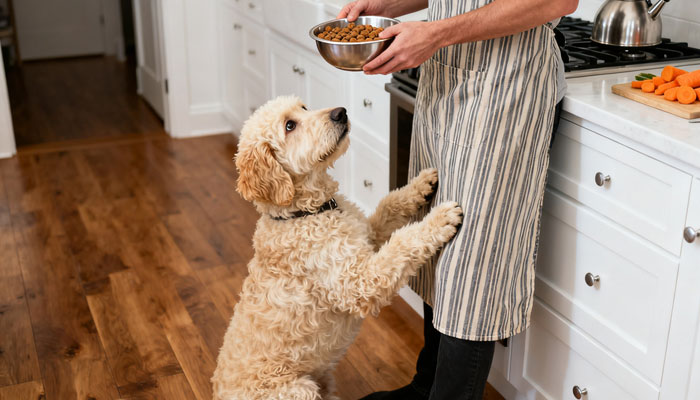Goldendoodle Health and Care

Goldendoodle inherited the best of both Golden Retriever and Poodle: the friendly and gentle character of the former and the almost non-shedding coat of the latter; thus, gradually became a suitable companion dog breed for many families. While this breed carries the benefits of both parental lines, it is necessary to follow the systematic training and take preventive measures against health risks for life quality and longevity of the dog’s life.
I. Common Health Concerns in Goldendoodles
Hip and elbow dysplasia are a problem that mainly affects Golden Retrievers but is also present in Poodles and thus associated in Goldendoodles. These dogs’ disease signs include weak standing, limping and, in severe cases, restraining the dog’s mobility.
Eye diseases are among the other frequent disorders of Goldendoodles as progressive retinal atrophy (PRA) and cataracts. PRA leads to gradual sight loss ending in blindness, and at the start, the signs are so faint that only a veterinarian’s check can find them. It is good practice to take your dog to the vet for an eye test every six months to a year, especially if it is over 3 years old, to catch early signs of the disease.
Goldendoodle’s coat is either curly or wavy, making it a perfect environment for the accumulation of dust and skin flakes. Skin infection may develop if there is impure skin in the area of the dogs’ skin, inhaling, or eating allergens. Look for itchy skin, redness, and hair loss quite often; do not delay your visit to the vet in case any of those signs occur.
Also, you can provide a good source of Omega-3 fatty acids in their diet to support a healthy skin barrier.
II. Daily Care for Goldendoodles
Their curly coat is prone to tangling. Along with daily brushing with a slicker brush or comb 2-3 times a week is recommended, brushing starting from the roots and working through to the tips. Use pet shampoo to limit bathing to 1-2 times per month, which is safe for skin and avoids irritation. After hence, ensure skin is dried thoroughly to avert skin diseases due to moisture.
Choose a dog food ration with the right amounts of protein, fat, and vitamins according to the Goldendoodle’s age, weight, and activity level. Do not give them human food, especially food that is toxic to dogs such as chocolate, grapes, and onions. Limit the treats to prevent weight gain, which adds extra calories and may lead to joint and internal organ problems.
The Goldendoodles, inherited the Golden Retriever’s energetic nature, need to be exercised for a long time on a daily basis. Have 1-2 walks outdoors everyday, for 30 minutes to 1 hour each and then play frisbee or any other interactive game with them to touch and release their energy.
If food deposits on teeth are left neglected for a long time, it will lead to the production of tartar, which is at the origin of bad breath, periodontal disease, and may even lower the pet’s appetite as well as the health of internal organs. In our opinion, it is advisable to perform the cleaning of teeth 2-3 times a week utilizing a toothbrush designed for pets. This is a method of prevention against the accumulation of plaque. Furthermore, it is also possible to resort to pet chew sticks and dental treats, the use of which assists in the mechanical removal of the plaque due to the friction created by the animals.
admin
-
Sale!

Washable Pet Cooling Pad for Cats and Dogs
$10.99Original price was: $10.99.$9.99Current price is: $9.99. This product has multiple variants. The options may be chosen on the product page -
Sale!

Washable Cat Window Hammock Cooling Bed
$23.99Original price was: $23.99.$22.99Current price is: $22.99. -
Sale!

Tropical Amphibian Rainforest Tank, Lizard Cage
$38.99Original price was: $38.99.$36.99Current price is: $36.99. -
Sale!

Silent 4-in-1 Waterproof Charging Dog Hair Trimmer
$49.88Original price was: $49.88.$47.99Current price is: $47.99.